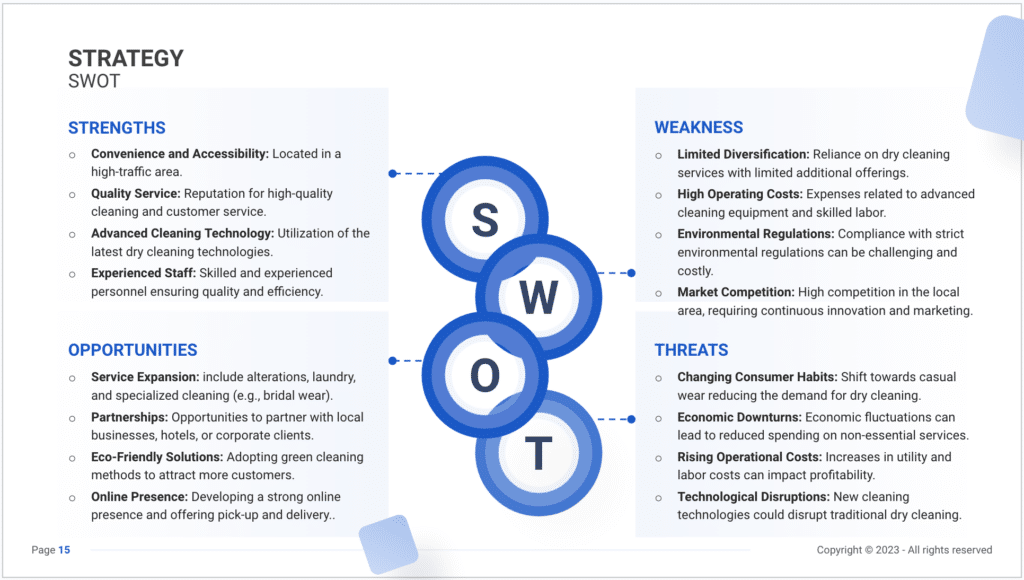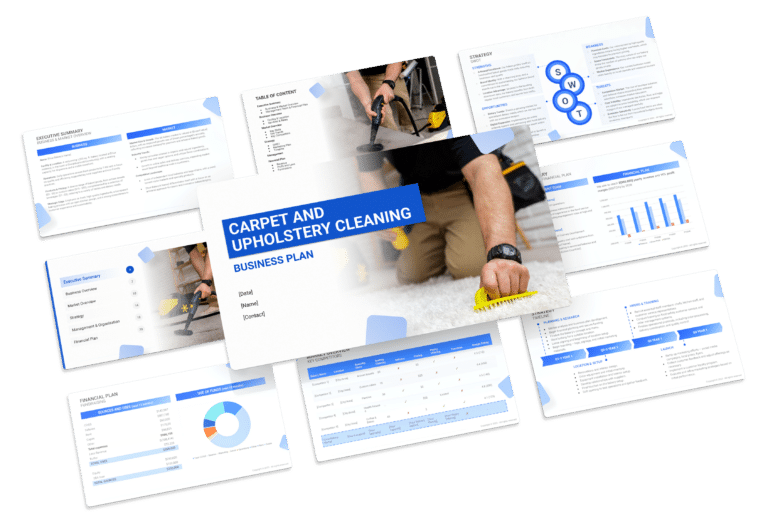SWOT Analysis for a Dry Cleaning Business (Example)

When making a business plan for a dry cleaning service, a key step is conducting a SWOT analysis. This process examines Strengths, Weaknesses, Opportunities, and Threats, helping owners evaluate both the business’s internal aspects and external factors.
In a dry cleaning business plan, SWOT analysis helps understand the company’s market position and identifies areas for growth. Strengths might include advanced equipment and a skilled team, while weaknesses could be a lack of service variety or location limits.
This article will cover various examples of strengths and weaknesses, offering advice to dry cleaning business owners on how to use this information in their strategic planning.

Strengths
Dry cleaning services possess inherent strengths that set them apart in the competitive cleaning industry.
- Specialized Expertise in Garment Care: Dry cleaners excel in the specialized care of garments, using techniques that preserve fabrics and extend the lifespan of clothing.
- Example: Promoting expertise in delicate fabrics and offering specialized stain removal services attracts clients seeking premium garment care.
- Convenience and Time Efficiency: The convenience of drop-off and pick-up services, coupled with the time efficiency of dry cleaning, appeals to busy professionals.
- Example: Offering extended business hours, express services, and implementing a user-friendly mobile app streamlines the customer experience.
- Environmentally Friendly Practices: Many dry cleaners prioritize environmentally friendly practices, such as using eco-friendly solvents and adopting sustainable cleaning methods.
- Example: Communicating the use of eco-friendly cleaning agents and implementing recycling programs for hangers showcases commitment to sustainability.
- Quality Control and Inspection Processes: Rigorous quality control and inspection processes ensure that garments are returned in impeccable condition, instilling trust in customers.
- Example: Implementing a comprehensive inspection checklist and providing guarantees for garment quality builds credibility and customer satisfaction.
Weaknesses
Identifying weaknesses is crucial for dry cleaners to enhance service quality and address potential challenges.
- Chemical Dependency: Dry cleaning services heavily rely on chemicals, and mishandling or overuse can lead to damage to fabrics and environmental concerns.
- Example: Regularly training staff on proper chemical usage and investing in advanced equipment to minimize chemical waste mitigates environmental impact.
- Dependency on External Factors: Dry cleaning operations may be impacted by external factors such as economic downturns, affecting consumer spending on cleaning services.
- Example: Diversifying service offerings to include garment repair and alterations during economic downturns can maintain revenue streams.
- Perceived High Costs: The perceived high cost of dry cleaning services may deter budget-conscious customers.
- Example: Offering loyalty programs, discounts for bulk orders, and transparent pricing structures helps address cost concerns and attract a wider clientele.
- Limited Service Differentiation: Some dry cleaners may struggle with service differentiation, making it challenging to stand out in a crowded market.
- Example: Introducing specialized services, such as wedding dress preservation or vintage garment restoration, distinguishes the dry cleaner in the market.
Opportunities
Identifying and capitalizing on opportunities is essential for dry cleaners aiming for growth and adaptability in a competitive market.
- Expansion of Services: Expanding services beyond traditional dry cleaning, such as offering home textile cleaning or shoe repair, broadens the customer base.
- Example: Collaborating with local businesses for specialized services and marketing the expanded service portfolio attracts a diverse clientele.
- Digital Marketing and Online Presence: Leveraging digital marketing and establishing a robust online presence enhances visibility and attracts tech-savvy customers.
- Example: Investing in social media marketing, maintaining an informative website, and offering online scheduling options enhance customer engagement and accessibility.
- Partnerships with Local Businesses: Forming partnerships with local businesses, such as fashion boutiques or wedding planners, creates opportunities for collaboration and mutual growth.
- Example: Collaborating with wedding planners for bridal gown cleaning or partnering with fashion retailers for exclusive promotions amplifies business reach.
- Customized Customer Loyalty Programs: Implementing customized customer loyalty programs, with perks such as discounts and priority services, fosters long-term customer relationships.
- Example: Introducing a tiered loyalty program with increasing benefits based on the frequency of service usage encourages repeat business and customer loyalty.
Threats
Anticipating and mitigating threats is crucial for dry cleaners to ensure resilience and sustainability in a dynamic market.
- Competition from In-House Laundry Services: In-house laundry services in residential and commercial spaces may pose competition to traditional dry cleaners.
- Example: Emphasizing the expertise, quality, and convenience of professional dry cleaning services through targeted marketing differentiates the dry cleaner from in-house alternatives.
- Economic Downturns: Economic downturns can lead to reduced consumer spending on non-essential services, impacting the demand for dry cleaning.
- Example: Implementing cost-effective marketing strategies, such as bundle discounts or referral programs, during economic downturns can help maintain customer loyalty.
- Technological Disruptions: Rapid technological advancements may require dry cleaners to adapt to new cleaning technologies and automation.
- Example: Investing in training programs for staff to handle new technologies and staying informed about emerging trends ensures the dry cleaner remains competitive.
- Regulatory Changes and Environmental Regulations: Evolving environmental regulations may impact the use of traditional dry cleaning solvents and require adaptation to new cleaning methods.
- Example: Proactively adopting eco-friendly practices and staying informed about changing regulations ensures compliance and environmental responsibility.





